How to Add Music or Audio to PowerPoint
Making a presentation can be challenging. One of the ways you can achieve this is by adding music to the presentation, something we do not get to see every day. You can add music, an animated GIF to PowerPoint, and more which can be played during the slide show.

You can choose to play the music on a single slide or in the background for the entirety of the presentation. The requirement for adding audio to your presentation is t it the file needs to be on your computer. You can not embed an audio file from the web. That said, we will go through downloading music for your presentation down below.
In this article, we will take you through the process of adding any type of audio to your PowerPoint. In addition, you will also learn how to add a video to your presentation without having to display a video during the slide show. So, without further ado, let us get right into it.
1. Add Music from your Computer
The easiest way of adding music to your presentation is by uploading it from your computer. This means you will need to have the audio file on your drive, ready for upload. Once you have an audio file, the rest of the procedure is relatively easy.
If you like a song/music but do not have it on your computer, there are several ways of downloading it to your computer. There are multiple websites on the internet that allow you to download an audio file to your computer. A simple Google search will help you in such a case.
In addition, there are various websites that provide royalty-free songs. Chosic, and SoundCloud are some of the examples of such websites. Once you have the audio file on your computer, follow the instructions down below to do this:
- To start, open the Microsoft PowerPoint presentation on your computer.
- Once the presentation is open, navigate to the slide where you want to add the music.
- After that, switch to the Insert tab in the menu bar.
- On the Insert tab, click on the Audio option in the right corner.

Video and Audio Options - From the drop-down menu, choose the Audio on My PC option.
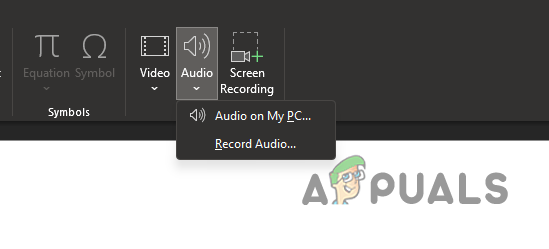
Adding Audio to PowerPoint - After that, on the Browse window, navigate to your audio file and open it up. Ensure the file you choose is an audio file, in MP3 or a similar format. In case it is a video, jump to the 4th method below.
- Once you add an audio file, an audio icon will appear on the screen.
- You can move the icon to any desired location. Hit the Play button to listen to the audio. You can adjust the volume from the volume icon at the end.

PowerPoint Audio Icon
1.1 Editing an Audio File in Microsoft PowerPoint
After adding an audio file to your PowerPoint presentation, you may want to edit it or make slight changes. Microsoft PowerPoint gives you a handful of features you can use to make the audio file fit your needs.
When you click on the audio icon after adding an audio file, two new tabs appear in the menu bar, Audio Format and Playback. Audio Format can be used to edit the audio icon in case of an MP3 file on the slide. You can also use it in case of a video file.
In addition, Playback allows you to edit the audio file itself. You can choose to trim the audio, and apply some effects like fade in, fade out and more. To do this, follow the instructions down below:
- First, click on the audio icon on your slide.
- In the menu bar, click on the Audio Format option.

Audio Format Tab - On the Audio Format tab, you can view several options. These can be helpful when you wish to make visual changes to the video on the slide or the audio icon.
- After that, click on the Playback option in the menu bar.
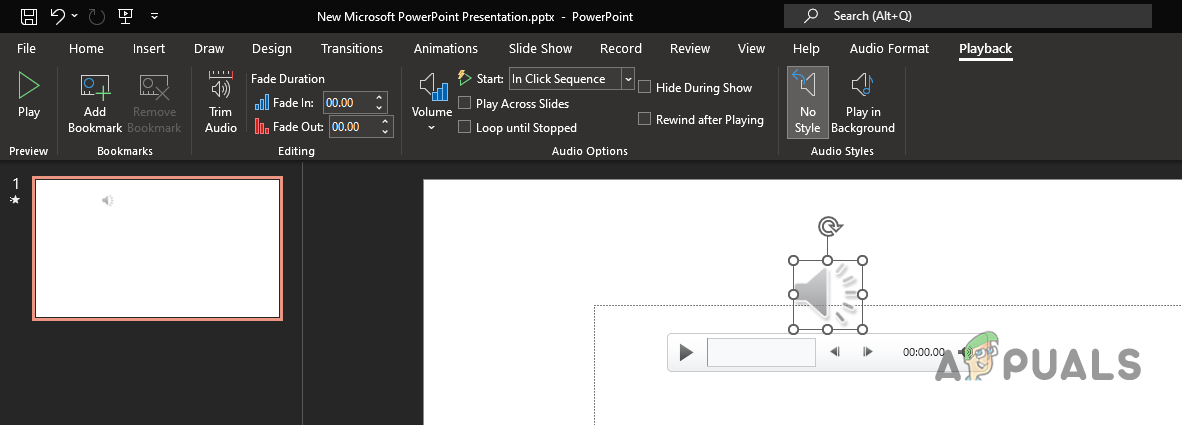
Playback Tab - In the Playback tab, you will find options to help you edit the audio file. You can trim the audio track if you want, apply fade effects to the soundtrack, and more.
- You can use the Loop until Stopped checkbox if you want the song to loop. Explore the options to find out more.

Loop Audio until Stopped
2. Record Audio for the Presentation
If you do not want to add an existing file but rather record something yourself, you can do so using PowerPoint. While browsing the audio options, you will see the Record Audio option that lets you record a message from your microphone.
Follow the instructions down below to record audio in PowerPoint:
- To start, navigate to the slide where you wish to play the recorded audio/message.
- After that, switch to the Insert tab in the menu bar.
- At the right corner, click on the Audio option.

Video and Audio Options - From the drop-down menu, choose the Record Audio option.

Adding Audio to PowerPoint - A new dialog box will appear. Give the audio you are about to record a name.
- To start recording, click on the red circular icon.
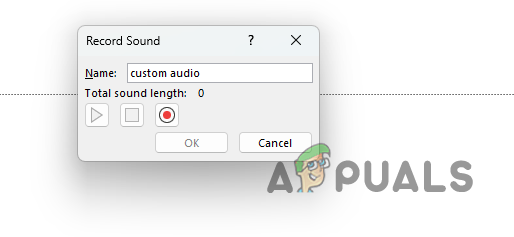
Starting a Custom Recording - After you record your message/audio, click on the red square icon to stop recording.
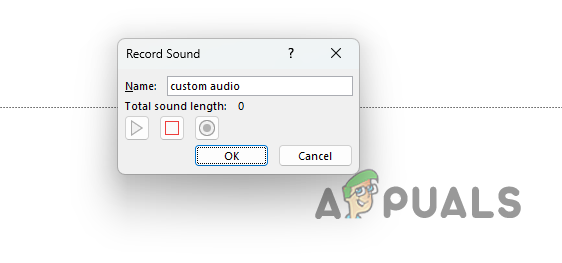
Recording an Audio - Once you do that, an audio icon will appear. You can use the controls provided to play the audio as well as edit it using the Playback tab.

Playback Tab
3. Play Music in the background in PowerPoint
After you add a song or music file to your presentation, you can choose to play it on a single side or in the background throughout the slide show. In case you want to do the latter, PowerPoint gives you the functionality of doing so.
Follow the instructions down below to play music in the background of a PowerPoint presentation:
- First, you will have to add the audio file to your presentation. You can do this by following the 1st method above.
- Once you do that, click on the audio icon that appears.

PowerPoint Audio Icon - In the menu bar, switch to the Playback tab.

Playback Tab - There, you can choose how you want to play the audio. Use the Start drop-down menu to play it on the slide individually.
- You can use the Automatically, In Click Sequence or When Clicked On options to choose how the audio is played. If you use one of these options, the audio will stop when you move to the next slide.

Playback Start Menu - For playing music in the background throughout the presentation, click on the Play in Background option at the end of the Playback tab.

Play Audio in Background - To ensure the music starts again after ending and across all of the slides, tick the Play Across Slides and Loop until Stopped checkboxes.

Playing Audio Across All Slides Continuously
4. Use Video as Audio in PowerPoint
If you want to use the audio of a video in your PowerPoint presentation but do not want to show the video, do not worry, as we will show you how to do just that in this method. Follow the instructions down below for this purpose:
- In your PowerPoint presentation, navigate to the slide where you want to play the audio.
- After that, switch to the Playback tab in the menu bar.

Playback Tab - Click on the Video option at the end.

Video and Audio Options - From the drop-down menu, choose an option that fits you. If the video file is on your computer, click the This Device option. If you want to embed a video from the internet, click on the Online Videos option.
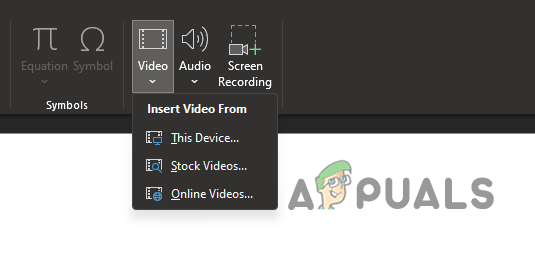
Adding a Video to PowerPoint - After you add the video, click on either corner of the video to make the preview smaller.
- Once you make it smaller, drag the video off of the slide to either side. Doing this will play the audio depending on your Playback options and not show the video during the slide show.

Dragging Video off of the Slide - After doing that, you can use the options in the Playback tab to adjust how the video plays.

Playback Tab